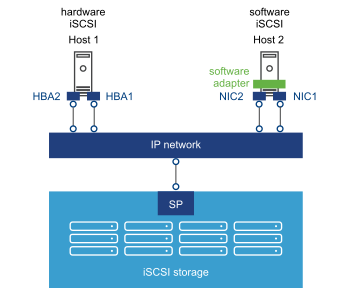With iSCSI, SCSI storage commands that your virtual machine issues to its virtual disk are converted into TCP/IP protocol packets and transmitted to a remote device, or target, on which the virtual disk is located. To the virtual machine, the device appears as a locally attached SCSI drive.
To access remote targets, the ESXi host uses iSCSI initiators. Initiators transport SCSI requests and responses between ESXi and the target storage device on the IP network. ESXi supports the following types of initiators.
- Software iSCSI adapter - VMware code built into the VMkernel. Allows an ESXi host to connect to the iSCSI storage device through standard network adapters. The software initiator handles iSCSI processing while communicating with the network adapter.
- Hardware iSCSI adapter - Offloads all iSCSI and network processing from your host. Hardware iSCSI adapters are broken into two types.
- Dependent hardware iSCSI adapter - Leverages the VMware iSCSI management and configuration interfaces.
- Independent hardware iSCSI adapter - Leverages its own iSCSI management and configuration interfaces.
See the vSphere Storage documentation for details on setup and failover scenarios.
You must configure iSCSI initiators for the host to access and display iSCSI storage devices.
iSCSI Storage depicts hosts that use different types of iSCSI initiators.
- The host on the left uses an independent hardware iSCSI adapter to connect to the iSCSI storage system.
- The host on the right uses software iSCSI.
Dependent hardware iSCSI can be implemented in different ways and is not shown. iSCSI storage devices from the storage system become available to the host. You can access the storage devices and create VMFS datastores for your storage needs.
